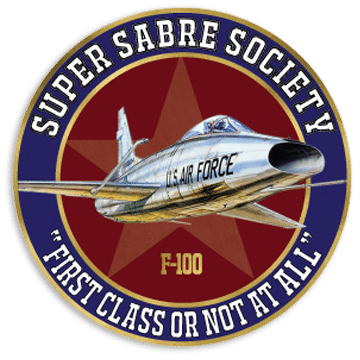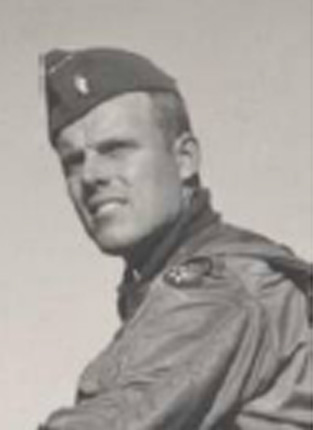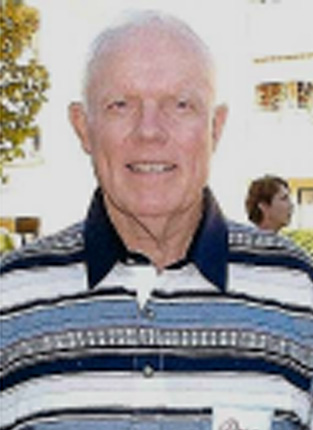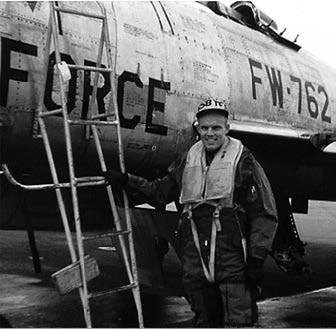Gear Up Landing!
I was in the 50th Tactical Fighter Wing at Hahn Air Base in West Germany in 1961. When the East Germans caused some problems with air traffic into West Berlin, we started sitting alert with air-to-air missiles (AIM-9s). With no air-to-air radar, we were strictly daytime capable, so we were on 15-minute alert from 30 minutes before sunup until 30 minutes after sunset in Berlin in case of trouble in the air corridors into Berlin.
In the winter, when it got dark around 4:30 PM or so, someone “in wing” got the bright idea of launching us about 30 minutes before sunset. We had to file an instrument flight plan called a DD-175 and stand by for a scramble. If anything happened, we would be airborne and could respond quickly to the situation, and if nothing did, then we just went ahead and got 2 hours of nighttime flying. It helped the wing out with getting in its programmed flying time (hard to do at Hahn, especially in winter when the weather was the worst), and if one of the planes broke, maintenance had all night to fix it and get it back on alert the next morning. Just what we needed! I must have gotten 30-40 hours of nighttime every 6 months.
One night, I was leading the alert flight with three other troops in my flight. As we were taxiing out, I got a flight control failure light and had to abort the mission and return the plane to the flight line. I thought, “Hot damn, I get to go home early tonight!” I turned the flight lead over to #3, taxied back in, and went back to squadron operations. When I walked in, they wanted to know what the deal was, and I told them. “Great, your flight has night mobile, and you are the only one still here!”, they said. (When planes were flying, a pilot was stationed in a small glass-enclosed facility near the end of the runway where he could monitor the radio, observe planes landing and taking off, and provide any assistance needed. One key duty was to check landing aircraft to make certain their landing gear is down.) Lucky me! If it was anything we hated worse than mobile, it was night mobile in that cold little box.
After sitting out there for about 2 hours and 30 minutes, my flight started to return. There was a cloud ceiling of about 400-500 feet and 1-mile visibility in fog, so the aircraft were making their final approach with an assist from a ground-control radar (GCA) unit. I heard the first bird check in with GCA, come down final, and land. Then came #2, also under GCA control, and landed with no problem. I never heard anything from #3, and all of a sudden he popped out of the fog with his landing lights on and landed. I later found out that GCA brought him in too close to #2, so they put him on a different channel and didn’t notify us at mobile. Thus I heard nothing. The F-102 squadron at Hahn was also flying that night, and one of their pilots was out there in mobile control with me. When #3 landed, the F-102 troop commented that there were sparks as he landed, and I said, “Yeah, that’s his tail skid.” (The F-100 had a tail skid that protected the tail of the aircraft on landing, and on a good landing, this skid often scraped the runway slightly.) To which he replied, “You must have one hell of a big tail skid on that bird.” I turned to look, and sure as shit, he had landed on his 275-gallon wing tanks with gear up. There had been several accidents in which an F-100 with 275-gallon fuel tanks under the wings landed with gear up.
The aircraft had then been raised, the gear lowered, and the plane towed back in with almost no damage except for needing new wing tanks. This landing shouldn’t have done much damage to the bird other than grinding the tanks down, but in this case, just as the plane stopped, the pilot (a little excited) blew the canopy. It went up and came down right on the tail! Of course, there was an accident investigation board. Whenever an aircraft is involved in an accident, a board of officers is convened to determine the cause of the accident and what corrective action, if any, is required. The following is basically an accurate account of a key part of the board’s interview with me.
INVESTIGATOR: What flight is this pilot assigned to in the 10th Tactical Fighter Squadron?
ME: “C” flight, I responded.
INVESTIGATOR: Who is his flight commander?
ME: I am.
INVESTIGATOR: Who was leading the flight on alert?
ME: I was.
INVESTIGATOR: Who signed the DD-175 for this flight?
ME: I did.
INVESTIGATOR: Did you conduct a preflight briefing for the anticipated flight?
ME: I sure did. (I was hoping he would ask me if I briefed him to lower his gear before landing, and I was going to give him the wise-ass answer that I didn’t brief him to raise the gear after takeoff, either, but no such luck.)
INVESTIGATOR: Who was on mobile control at the time of the accident?
ME: I was. (After all this, I was expecting someone to mention ‘supervisor error’ but it didn’t come up)
Later, listening to GCA’s tape of the radio conversation during the flight, the pilot had reported “gear down,” so we don’t know what went wrong. I think he must have put the gear down, thus the call. I doubt if he would make this call if he hadn’t lowered the gear and checked to see that he had the three green lights indicating the gear was down and locked. The gear was obviously up when he landed, so I guess for some reason he raised it during the final approach. I had talked with the pilot later, a very good pilot, but he didn’t know what had happened.
When an accident occurred, the investigating board looked at all involved to determine if there were any errors by personnel other than the pilot involved. For example, had the wing established standard operating procedures that were improper and could have contributed to the accident? In this case, a supervisor might share in the blame. I had a feeling that “Supervisory Error” was going to enter into the conversation shortly, but for some reason it never did. The wing commander sat in on this, and I explained to him that the F-100 was the only aircraft that I had flown that didn’t have the landing lights tied into the gear system. On other planes, the landing lights would not come on unless the gear was down. On the F-100, there was a switch that controlled the landing lights, and activating it would turn the lights on, regardless of whether the gear is down or not. Thus the F-100 pilots felt that night mobile was not very useful, because with those bright lights shining in the eyes of the mobile control troop, one couldn’t see if the gear was down or not.
FINAL RESOLUTION: I was the Wing Commander’s pilot – when he wanted to fly, he scheduled me to take him up in an F-100F. Therefore, I knew him well, and he understood the problem with the landing lights on the F-100. The result — no supervisory error and they did away with night mobile!!! From then on we put a pilot up in the nice warm control tower where he could drink coffee, monitor the radios and give assistance if needed, and that sure beat night mobile. Out of crap, good things sometimes happen.
About Don:
Don “Stymie” Nichols retired from the Air Force at Hickam AFB on December 31, 1979, and was employed by Ling Temco Vought (LTV) on January 1, 1980, under contract to the Navy (COMTHIRDFLT) on Ford Island. LTV developed tactics for the Navy’s F-14s.
He moved back to LTV offices in Arlington, TX, in 1985 to continue work as an analyst on aircraft and weapons systems projects. The division was eventually purchased by Lockheed Martin and I retired from LM after 20 years on 31 December 31, 1999.
After retiring, Don worked for the city of Arlington as a marshal on a city golf course. “A great deal – got paid, played golf anytime I wanted and got all the balls I could find!” In September of 2007, the Nichols moved to Air Force Village West near March ARB, CA, a military retirement center for officers of the seven uniformed services.
“A great place to live – at least 24 retired general officers think so!”
Donald “Stymie” Nichols (LtCol USAF, Ret) “Headed West” on August 3, 2021.
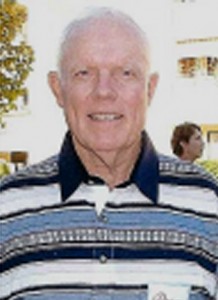 Don Nichols flew the F-100 D&F with the 506th Strategic Fighter Wing/Tactical Fighter Wing from 1956-1958. He then flew with 458th Tactical Fighter Squadron/50th Tactical Fighter Wing out of Ramstein AB, Germany from 1958-1959. From 1959-1961 he flew the C/D/F models with 4511th Combat Crew Training Squadron out of Luke AFB, AZ.
Don Nichols flew the F-100 D&F with the 506th Strategic Fighter Wing/Tactical Fighter Wing from 1956-1958. He then flew with 458th Tactical Fighter Squadron/50th Tactical Fighter Wing out of Ramstein AB, Germany from 1958-1959. From 1959-1961 he flew the C/D/F models with 4511th Combat Crew Training Squadron out of Luke AFB, AZ.
From 1961-1964 he served with the 50th Tactical Fighter Wing out of Hahn AB, Germany flying the F-100 D and F.
More information about services for Stymie will be posted as they become available.
